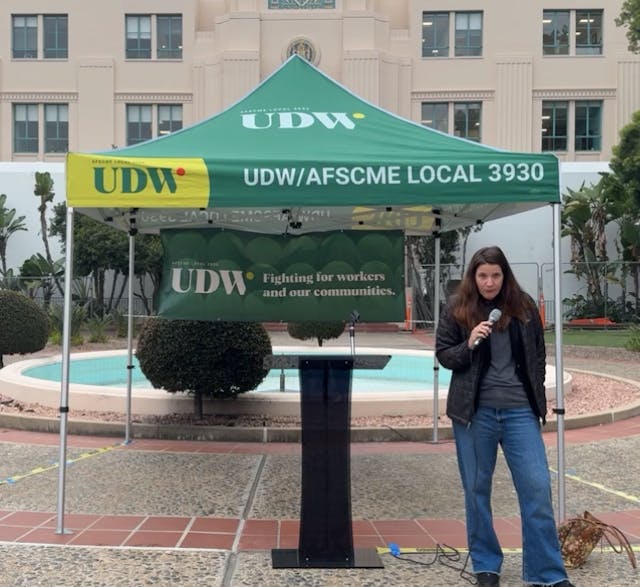Acapulco: Back from the Brink?
Frontera NorteSur
On a hot weekend day, informal vendors bounce up and down Acapulco’s Caletilla Beach. Shuffling among the relaxing beach lovers, they peddle fruit, snacks, jewelry and other trinkets. Budget-savvy Mexican families toting ice-chests descend on the tiny but comfy piece of sand.
Waiters Rafael Cisneros and Guillermo Ruiz wait for the customers who will make the difference. Non-salaried and without any benefits, the men labor on a 20 percent commission basis. For every $10 restaurant check, they earn $2. No sales mean zero pay for the day.
Cisneros recalled that a North American tourist once told him: “’A dog lives better in the U.S. than a poor person in Mexico.’”
At 61, Ruiz has been through the many ups and downs of Acapulco. Lately, the economic trajectory has mostly been downward, he said.
“Every year is worse than the year before,” the seasoned server said. A soft-spoken man, Ruiz remembered working decades ago on La Roqueta Island in the bay, when the tourist breakdown was about 50 percent foreigner and 50 percent Mexican national. Nowadays, the number of international visitors can practically be counted on one hand.
But Ruiz is not so worried. He is a member of the Jeho-vah’s Witnesses, a religious sect that is increasingly visible in Acapulco. Ruiz said he once squandered money on booze and women, but has since chosen a straight-arrow path.
“The money lasts longer because I don’t buy useless things,” Ruiz said. Moreover, the current economic woes don’t necessarily trouble the devout man.
“This doesn’t surprise us.” he added. “We’re living in the end times.”
But for Acapulco’s movers and shakers, 2014 represents the new beginning of good times.
Although their city was turned upside down by crime and violence in the past decade, tourism industry boosters and government officials are pulling out the stops to reverse a negative image (acquired from Acapulco’s status as the most homicide-ridden city in Mexico during 2012 and 2013), assuring the public the Bay of Santa Lucia is a safe place to vacation. And they have some successes under their belt.
In January 2014, the old warhorse of Mexico tourism hosted the acclaimed Acapulco International Film Festival for the ninth year, with Sylvester Stallone showing up as this year’s guest of honor. In a widely broadcast interview with Televisa’s Adela Micha, old Rambo spoke highly of Acapulco and Mexico.
Following up on the film fest, the Guerrero State Secretariat of Tourism Promotion (SEFOTUR) reported that the 97 percent hotel occupancy rate in the Punta Diamante zone, coinciding with the Mexican Tennis Open which concluded earlier this month, had exceed expectations.
A year ago, the Costera main tourist drag resembled a military proving ground as convoy after convoy of soldiers, marines and police cruised up and down the bayside boulevard. While patrols still make their presence known, the security deployment is less intense. In contrast, rolling crowds pack popular Condesa Beach on some weekend evenings.
According to the municipal government, more than 94,000 Mexican tourists visited Aca-pulco the holiday weekend of March 15-17, pumping around $20 million into the economy. The 83.6 percent hotel occupancy rate was nearly 13 points higher than in the same weekend of 2013, according to the official statistics.
Different branches of government are injecting tax money into a tourism rebound. For instance, SEFOTUR has announced that it will spend about $2 million to help stage 10 international conferences this year in Acapulco and Ixtapa up the Pacific coast, including June’s Mexican National Petroleum Congress.
Nationally, Acapulco has a powerful ally in Claudia Ruiz Massieu, Mexico’s current federal tourism secretary, who just happens to be from a prominent local family.
A member of President Pena Nieto’s PRI party, the 41-year-old Ruiz is the niece of former President Carlos Salinas and the daughter of former Guerrero Governor Jose Francisco Ruiz Massieu, who was assassinated in Mexico City in 1994.
Ruiz is widely considered a possible candidate for the Guerrero governorship in 2015. If the onetime federal lawmaker follows the same career path as her father, she will be in the political pipeline for the Mexican White House and in the running to become Mexico’s first female president.
As one of her first orders of business, Ruiz took charge of the committee that will oversee the return of the famed Tourism Tianguis to Acapulco in 2015 after a controversial, three-year rotation to other Mexican cities. A mega-event in the tourist business, the big gathering is the place for industry wholesalers and insiders.
Acapulco’s powers-that-be are also attempting to score another if more elusive coup in the tourist world: the return of the notorious if free-spending spring breakers from the U.S. While the spring vacation promoter Student City prominently listed Acapulco packages beginning at $999 on its website this season, few if any U.S. young people took up the offer, according to news reports. Local officials vow to try again next year.
For the 21st century, the city is getting new infrastructure, including a big tunnel through the hills to facilitate traffic flows and a big city-style public transportation system called the Acabus. Acapulco apartment manager Apolonio Ceballos is among supporters of the bus project.
“It will help out all the residents and get rid of the old system,” Ceballos said. “It’s bad. The drivers do whatever they want.”
Long known for running more than a few pedestrians over, many drivers dash through the streets with stereos blaring electronic, rock or banda music. Supposedly banned several municipal governments ago, drivers’ assistants called chalanes hang from the side doors of buses trying to snag passengers like a fisher casting for a big fat tuna.
Many buses sport gaudy murals and names. To name a few: “Wolverine,” “Fandango” and “Sexi Bitch,” the latter featuring two women, a blonde and a brunette, engaged in a provocative act. Some of the four-wheeled fiestas still display signs that demand: “No Acabus.”
The Acabus is a key barometer for the new Acapulco. The ultimate success or failure of the ambitious project will indicate whether they city is moving ahead or staying mired in a whirlpool of special, often obscure interests. Although the Acabus’ passenger terminals are completed, no buses run to service them as of yet, while behind-the-scene negotiations take place between state officials and the possible bus system concessionaires.
Public safety is the million dollar question on almost everyone’s lips. A long-ticking social time bomb blew up in 2006, when the drug cartel wars came to town and even played out in front of startled tourists.
Many Acapulquenos say the security situation has since improved, with important caveats.
Three years ago fearful residents stayed home after 9 pm, and the drug-fueled violence made some young people “think twice” about consuming illicit substances, said Dario Velasco, a young activist with the #YoSoy 132 organization.
“(Violence) affects us a lot,” he added, “but it has gone down.”
Roberto Ramirez, editor for the Guerrero edition of La Jornada daily, noted a reduction in killings, saying the previously “scandalous” episodes of headless or hanging bodies displayed in public had been replaced by a more subdued violence of “one, two and three or more” killings here and there.
It’s a pattern that’s taken shape in other cities like Ciudad Juarez or Tijuana, where murder now largely takes place in poorer neighborhoods away from the eyes and ears of tourists. If class and demographic differences were glaring in Mexico prior to the advent of the so-called drug war, the violence has only accentuated social cleavages.
Three years ago, the city’s residents were terrified to speak out, Ramirez said, while reporters banded together in groups to cover delicate stories or simply just stopped writing about risky subjects. The Mexican journalist credits Acapulco’s teachers, who shut down schools and staged mass protests in 2011 against extortions, kidnappings and killings, for beginning to turn the tide.
“I see a more participatory society on the security issue.” Ramirez said. “It’s not like 2011.”
In Acapulco and Mexico, hard numbers are difficult to gauge, because of different reporting methodologies by law enforcement agencies or the fact that many crimes go unreported.
For 2012, the Mexico City-based Citizen Council for Public Safety rated Acapulco the second most violent city in the world, falling only behind San Pedro Sula Honduras, with 1,170 murders, or 143 killings per 100,000 residents.
Based on government and journalistic sources, Tijuana’s Zeta newspaper reported this month that Acapulco’s 883 murders in 2013 still made it the most violent city in Mexico. If the numbers are accurate, murder dipped about 25 percent last year, but remained historically high-even by the standards of a city and state where violence rooted in land, political and personal conflicts has long marred life.
“Violence has always been here,” Ramirez reflected. “Now there’s a larger criminal violence.”
No murder statistics are yet publicly available for the first quarter of 2014, but homicide stories are much less noticeable in the local press than at the same time a year ago.
Meantime, Acapulco’s residents anticipate a much-needed flow of cash next month when the city’s biggest Mexican tourist season of the year, Semana Santa, or Holy Week, comes to town. Aiming for 100 percent hotel occupancy, officials are predicting the best Semana Santa in years.
Frontera NorteSur: on-line, U.S.-Mexico border news Center for Latin American and Border Studies New Mexico State University Las Cruces, New Mexico.






